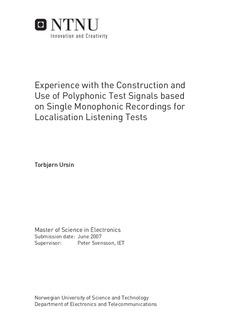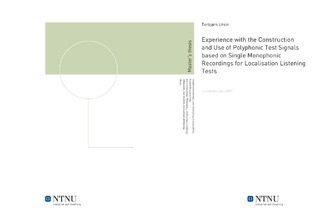| dc.description.abstract | The paper presents experiments made in search of answers to two principal questions: 1. Can one single musician be made to sound like several musicians playing together? 2. In a music ensemble, where one of its constituents has a distinctive spectrum; how do the deviant spectral components influence a listener s ability of localising the source? In the first part of the experiment, a flute ensemble was attempted simulated. Based on a recoring of one flute playing a short piece, the flute was multiplied into a quintet. On the way, several properties were manipulated in an attempt to make the quintet sound like a real quintet; timing, spectrum, intensity, and phase. In the second part, one flute in a quintet was subject to a spectral tilt, i.e. high frequency components were boosted while low frequency components were diminished. A test panel was engaged to help evaluating the questions. First, the panel compared the simulated quintet to a reference quintet, trying to identify the simulation from the reference. Subsequently, listening to a reference quintet, the panel tried to localise the one flute which had undergone a spectral tilt. A musical piece was played 5 times; first, one of the flutes was moderately tilted, then the tilt s magnitude was increased for every run until eventually being noticeable. For each run, the test panel was asked to indicate the tilted flute, or a random flute if none appeared tilted to them. The majority of the test panel did not manage to tell the simulated quintet from the reference. However, the reference may have been imperfect, and the simulation process somewhat affects sound quality. When it comes to localisation, a rather excessive tilt was necessary for the test panel to be able to localise it - even though more moderate tilts were clearly audible. | nb_NO |

